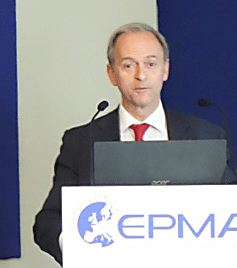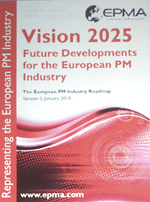EPMA Anniversary Seminar recognises a long history of Powder Metallurgy in Europe
This year the European Powder Metallurgy Association (EPMA) celebrates its 25th anniversary. To help mark the occasion the trade association organised a special 25th Anniversary Seminar to highlight the development of the European Powder Metallurgy industry.
The seminar took place in London, UK, on June 6th following the EPMA’s General Assembly and celebratory dinner at Stationers Hall on June 5th, and was open to all association members.
The European Powder Metallurgy Association
Formed in Brussels in 1989, the EPMA has over the last 25 years represented the European Powder Metallurgy industry at both regional and international level. The association has led important work on industry standards and been responsible for coordinating a number of research and technology projects as well as producing a range of educational aids and organising short courses, PM summer schools and international conferences.
The EPMA is managed from its secretariat in Shrewsbury, UK, and has been headed by Executive Director Jonathan Wroe for the past 13 years. Wroe took over the position in 2001 when former Executive Director Bernard Williams retired from the post. Williams, who along with leading figures from the PM industry, was key in the association’s inauguration in 1989 and responsible for steering the EPMA during its formative years.
Over the last 25 years the EPMA has had five presidents, and it was fitting that the anniversary seminar began with a presentation by past EPMA President Dr Cesar Molins.
Molins, who is Director General of AMES SA, Spain, was president of the trade association from 2001 to 2007, and his presentation charted the history of the association, identifying key personnel and recalling its many achievements since 1989.
Development of the European Press and Sinter sector
Professor Paul Beiss, RWTH Aachen, Germany, who received the EPMA’s Distinguished Service Award in 2010, presented a review of the development of the European press and sinter sector. Beiss made reference to the early advances in sintered bearing production in the 1930s and the first structural parts developed for General Motors oil pump gears in the early 1940s.
His presentation looked at early die and tooling systems, and how advances such as spark erosion impacted the industry. The early methods of iron powder production and the developments in sintering technology, especially for the mass production of shell driving bands in Germany in the Second World War, were identified during this interesting presentation.
The Hard Materials industry
A look at the history of the Hard Materials sector was undertaken by Dr Leo Prakash, Kyocera Unimerco, Denmark. Prakash traced the beginning of the industry in Europe back to the early 1920s when there was a rush to patent key aspects of the technology. The lack of patents applying to Russia was highlighted as having a significant impact on the development of the industry in that region.
Prakash stated that in recent times the growth of the industry has been focused in China, which has seen production increase ten-fold in the last few years. Prakash highlighted developments in production equipment, and acknowledged the importance of the sinter-HIP process. Another important development for the sector has been seen in the use of CVD and PVD coatings, substantially increasing the life of cutting tools. Prakash stated that the world market for Hard Materials is now estimated to be in the region of $110 billion globally.
Metal Injection Moulding in Europe
The Metal Injection Moulding (MIM) sector in Europe was reviewed by Bruno Vicenzi of MIMItalia srl. Recalling the history of MIM, Vicenzi noted that the European MIM industry was greatly boosted by the development of BASF’s Catamold feedstock system in the early 1990s. The work of Arburg in developing customised injection moulding machines for the relatively new process was also a driver for the growth of the industry.
Vicenzi provided a comprehensive list of MIM companies in Europe demonstrating the wide range of applications covered. He also recognised the many research projects underway in numerous establishments in Europe along with the successful three year MIM Thematic Network “MIMNet” organised by the EPMA which concluded in 2000 and resulted in the development of draft ISO standards for MIM materials. 2001 saw the creation of the association’s EuroMIM working group.
The Hot Isostatic Pressing (HIP) industry.
Dr Olle Grinder, also a recipient of the EPMA’s Distinguished Service Award in 2011, gave an overview of the Hot Isostatic Pressing (HIP) industry. Early examples of the HIP process date back to the mid 1950s in the USA, but it was in the early 1970s when Swedish company Stora (and Crucible in the USA) began commercialisation of the process to produce powdered high speed steel using HIP.
Grinder discussed the developments of powders for HIP, highlighting the importance of quality control and the powder cleanliness. The development of large HIP Equipment and their impact on reducing unit costs was covered in his talk, along with examples of parts produced by the process.
Market changing products in the history of PM
Key developments in the evolving market for Powder Metallurgy structural components were identified in a presentation by Dr Volker Arnhold, former Vice President – Global Advanced Engineering, at GKN Sinter Metals GmbH. Arnhold, who received the EPMA’s Distinguished Service Award in 2012, outlined a number of important milestones in the industry.
In the mid 1950s the introduction of PM valve seats gave the industry a high volume application, and highlighted the advantages of the PM process. Also in the automobile engine sector, the development of Powder Forged connecting rods in the 1970s and 1980s and main bearing caps in the early 1990’s were identified as important components. In automotive transmission applications the use of PM planetary carriers and synchroniser hubs has provided huge potential for the industry.
Looking to the future, Arnhold highlighted the potential for growth in PM automotive gear applications, a sector that could greatly increase the volume of PM used in the automotive market.
Additive Manufacturing
The last of the technology presentations covered perhaps the newest member of the Powder Metallurgy family, Additive Manufacturing (AM). Adeline Riou of Erasteel, France, provided an insight into this rapidly developing technology which, she stated, is offering “a design revolution.” Riou noted that the technology is not as new as some may think, with its routes dating back to 1990s when rapid prototyping systems using metal powders were first introduced. A wave of funding from both public and private sectors and high profile media coverage is, however, driving current development.
A number of examples of metal AM parts were shown along with videos demonstrating the processes. Riou stressed the importance of standards for the sector and highlighted the work of EPMA’s recently formed European Additive Manufacturing Group.
Future development needs in PM – and update to the EPMA roadmap
The day concluded up with a presentation by current EPMA President, Philippe Gundermann, looking at initial plans for the second of EPMA’s PM Roadmap. The first PM Roadmap was completed some ten years ago, with a number of its visions now a reality, such as the Global PM Property Database.
One of the main reasons for the roadmap is to promote PM technology outside of the PM industry, and Gundermann suggested that PM needs to be recognised as “a resource efficient production process” and become the “preferred metal shape forming technology”. The Vision 2025 PM Roadmap is due for publication in January 2015.
Subscribe to our FREE e-newsletter
Register to receive our FREE e-newsletter and a complimentary digital subscription to Powder Metallurgy Review magazine:
Useful links: Download PM Review magazine | News headlines | Browse articles
Photo Gallery: EPMA 25th Anniversary Seminar
Author: Paul Whittaker, Editor Powder Metallurgy Review & ipmd.net
[email protected]








